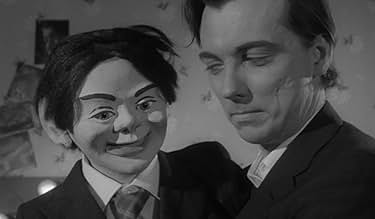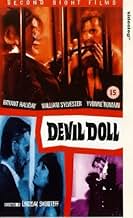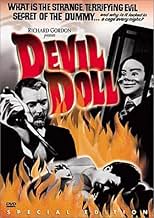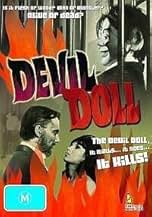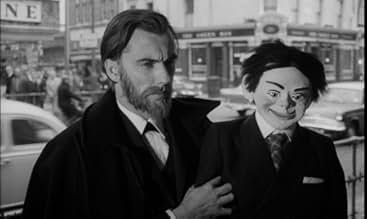Devil Doll
- 1964
- 1 h 21 min
AVALIAÇÃO DA IMDb
4,9/10
2,7 mil
SUA AVALIAÇÃO
Adicionar um enredo no seu idiomaAn evil hyponotist/ventriloquist plots to gain a heiress' millions.An evil hyponotist/ventriloquist plots to gain a heiress' millions.An evil hyponotist/ventriloquist plots to gain a heiress' millions.
- Direção
- Roteiristas
- Artistas
Francis De Wolff
- Dr. Keisling
- (as Francis de Wolff)
Redmond Bailey
- Backstage Crew
- (não creditado)
Anthony Baird
- Soldier
- (não creditado)
Tony Castleton
- Charity Ball Guest
- (não creditado)
David Charlesworth
- Hugo Novik
- (não creditado)
Lorenza Colville
- Mercedes
- (não creditado)
Sadie Corre
- Hugo the Dummy
- (não creditado)
Trixie Dallas
- Miss Penton
- (não creditado)
Keith Denny
- Audience Member
- (não creditado)
Margaret Durnell
- Countess
- (não creditado)
- Direção
- Roteiristas
- Elenco e equipe completos
- Produção, bilheteria e muito mais no IMDbPro
Avaliações em destaque
The Image DVD of this film includes both the original release and an alternate Continental version. There are the following differences in the film.
(a) the initial opening credits are slightly different. The original print has a separate starring credit for Bryant Haliday "as the Great Vorelli" but the continental print credits William Sylvester above Bryant Halliday (sic). There are also some differences in the production company credits with an "Anglo-Amalgamated" credit missing from the Continental print.
(b) 41m14s to 44m40s
The scene between Haliday and Sandra Dorne in Haliday's dressing room (a fairly important scene in establishing Dorne's character and providing a motive for her later murder) which ends with them going into a side room for some (off-screen) sex is missing from the Continental print. Instead, an entirely new scene has been substituted (16s longer in total) which shows Haliday's stage act once more. In this new scene (which does not appear in the original version and was especially filmed for the Continental print) he invites a woman on stage and hypnotizes her into performing a striptease which continues at length until the woman is topless.
(c) 48m15s
A shot of Dorne turning in her sleep is filmed in an alternate cut in the Continental print to show more of her exposed breast.
(d) 48m54s
In the follow-up shot of Hugo approaching to stab Dorne the Continental print has an alternate take in which you see her exposed breast.
(e) 49m47s to 51m07s
Sylvester has a phone conversation with an American colleague in Berlin. This man is accompanied by a young woman who fiddles with her hair and sits on his bed. In the theatrical print she is wearing a bikini and a see-through negligee. The Continental print is an alternate take in which she (the same actress) is topless.
In my view the original cut is definitely superior because the deletion of the dressing room scene from the Continental print (and its replacement by the gratuitous striptease) makes Dorne's subsequent murder abrupt and seemingly arbitrary - the character had also been hanging around the periphery of the action waiting for an appropriate exposition scene to explain her that, in this version, never comes.
(a) the initial opening credits are slightly different. The original print has a separate starring credit for Bryant Haliday "as the Great Vorelli" but the continental print credits William Sylvester above Bryant Halliday (sic). There are also some differences in the production company credits with an "Anglo-Amalgamated" credit missing from the Continental print.
(b) 41m14s to 44m40s
The scene between Haliday and Sandra Dorne in Haliday's dressing room (a fairly important scene in establishing Dorne's character and providing a motive for her later murder) which ends with them going into a side room for some (off-screen) sex is missing from the Continental print. Instead, an entirely new scene has been substituted (16s longer in total) which shows Haliday's stage act once more. In this new scene (which does not appear in the original version and was especially filmed for the Continental print) he invites a woman on stage and hypnotizes her into performing a striptease which continues at length until the woman is topless.
(c) 48m15s
A shot of Dorne turning in her sleep is filmed in an alternate cut in the Continental print to show more of her exposed breast.
(d) 48m54s
In the follow-up shot of Hugo approaching to stab Dorne the Continental print has an alternate take in which you see her exposed breast.
(e) 49m47s to 51m07s
Sylvester has a phone conversation with an American colleague in Berlin. This man is accompanied by a young woman who fiddles with her hair and sits on his bed. In the theatrical print she is wearing a bikini and a see-through negligee. The Continental print is an alternate take in which she (the same actress) is topless.
In my view the original cut is definitely superior because the deletion of the dressing room scene from the Continental print (and its replacement by the gratuitous striptease) makes Dorne's subsequent murder abrupt and seemingly arbitrary - the character had also been hanging around the periphery of the action waiting for an appropriate exposition scene to explain her that, in this version, never comes.
I actually liked this b/w low budgeter that made the rounds at the drive-ins back in the early-60s. It deserves better than the MST3K treatment since the acting isn't bad at all.
The Great Vorelli (Bryant Haliday) knows the art of transferring souls into inanimate objects, in the case a ventriloquist's dummy Vorelli uses in his stage act. He runs into rich, beautiful Marianne Horn (Yvonne Romain) and seeks to hypnotize her into marrying her and gain her inheritance. William Sylvester plays the reporter (and boyfriend) of Romain who's investigating Vorelli.
The ending fight scene between the dummy and Vorelli is unintentionally hilarious so I can see why MST3K picked it for an episode, but the rest of the film isn't played for laughs. Nice little twist when Sylvester walks in at the end of the fight.
The widescreen anamorphic Image DVD has both the Euro print with topless scenes, as well as the censored U.S. version. The poster named "35541m" has a pretty good rundown over the differences between the two written below. However, I should add that the Euro print is sharper and in slightly better shape than the U.S. print.
6 out of 10
The Great Vorelli (Bryant Haliday) knows the art of transferring souls into inanimate objects, in the case a ventriloquist's dummy Vorelli uses in his stage act. He runs into rich, beautiful Marianne Horn (Yvonne Romain) and seeks to hypnotize her into marrying her and gain her inheritance. William Sylvester plays the reporter (and boyfriend) of Romain who's investigating Vorelli.
The ending fight scene between the dummy and Vorelli is unintentionally hilarious so I can see why MST3K picked it for an episode, but the rest of the film isn't played for laughs. Nice little twist when Sylvester walks in at the end of the fight.
The widescreen anamorphic Image DVD has both the Euro print with topless scenes, as well as the censored U.S. version. The poster named "35541m" has a pretty good rundown over the differences between the two written below. However, I should add that the Euro print is sharper and in slightly better shape than the U.S. print.
6 out of 10
Devil Doll (1964)
*** (out of 4)
Effective and perfectly made British horror film has Bryant Haliday play The Great Vorelli, a hypnotist/ventriloquist who can do things that no other can. Why is that? Because his dummy actually has the soul of his former assistant in it and Vorelli plans on making another dummy and putting the soul of a woman (Yvonne Romain) he's hammered with in it. This film has an incredibly low rating on IMDb, which I'm sure is going to keep many people away but I'd guess a lot of those low votes come from people just giving it low votes because MST3K did an episode with this. A lot of other books and magazines praise this film and I'm going to do so as well. I normally tend to find British horror films a tad bit boring and while this one here begins to lose steam as it rolls along, it still manages to be quite effective. What's most impressive is the cinematography and editing, all of which is done on a very low budget. Some have said the film has a made for TV look but I'd disagree with this. Yes, it's mostly close ups used but I think this works out to be very effective because it puts us so close to Vorelli and the dummy that you can't help but feel as if you're under a trance as well. I really loved how the film was edited and this could be used as evidence that editing is the most important thing in a film. Just watch the first stage show where the dummy first begins to walk. It's rather obvious that a midget is doing the dummy but the way this sequence is put together makes it rather chilling when you see him start to walk. The ending, while a bit over the top, also features some great editing as well. I found Haliday to be quite pleasant in his role as was Hammer queen Romain. I wasn't too impressed with William Sylvester but he too was still better than you'd normally get in such a low budget film. I watched the European version of the film, which features a tad bit more nudity and features a few strange sequences like a striptease. This isn't the most original movie ever made but it's the perfect example of something done right with very little money.
*** (out of 4)
Effective and perfectly made British horror film has Bryant Haliday play The Great Vorelli, a hypnotist/ventriloquist who can do things that no other can. Why is that? Because his dummy actually has the soul of his former assistant in it and Vorelli plans on making another dummy and putting the soul of a woman (Yvonne Romain) he's hammered with in it. This film has an incredibly low rating on IMDb, which I'm sure is going to keep many people away but I'd guess a lot of those low votes come from people just giving it low votes because MST3K did an episode with this. A lot of other books and magazines praise this film and I'm going to do so as well. I normally tend to find British horror films a tad bit boring and while this one here begins to lose steam as it rolls along, it still manages to be quite effective. What's most impressive is the cinematography and editing, all of which is done on a very low budget. Some have said the film has a made for TV look but I'd disagree with this. Yes, it's mostly close ups used but I think this works out to be very effective because it puts us so close to Vorelli and the dummy that you can't help but feel as if you're under a trance as well. I really loved how the film was edited and this could be used as evidence that editing is the most important thing in a film. Just watch the first stage show where the dummy first begins to walk. It's rather obvious that a midget is doing the dummy but the way this sequence is put together makes it rather chilling when you see him start to walk. The ending, while a bit over the top, also features some great editing as well. I found Haliday to be quite pleasant in his role as was Hammer queen Romain. I wasn't too impressed with William Sylvester but he too was still better than you'd normally get in such a low budget film. I watched the European version of the film, which features a tad bit more nudity and features a few strange sequences like a striptease. This isn't the most original movie ever made but it's the perfect example of something done right with very little money.
What an act the Great Vorelli has, in the 1964 British horror thriller "Devil Doll"! Not only can he hypnotize audience volunteers to perform any kind of outlandish stunt, but he can also make his ventriloquist's dummy, Hugo, talk and act most uncannily lifelike. But how to explain Hugo's ability to locomote all by himself? That's what reporter Mark English (excellently portrayed by American actor William Sylvester) tries to find out, in this very effective little sleeper. While I would never dream of revealing Hugo's back story, I will say that he is a much creepier presence than the modern-day Chucky, if perhaps not as homicidal; the filmmakers of "Devil Doll" get maximum bang out of Hugo's merest eye movements and head turnings. It really is remarkable how much emotion can be inferred in the little puppet's homely mug; his is hardly a wooden performance! In addition to this living doll's eerie presence, the film boasts stunning B&W photography, uniformly fine acting (especially by Bryant Haliday as Vorelli, who comes off far more sinister here than the evil hypnotist played by Jose Ferrer in 1949's "Whirlpool"), intriguing FX (negative images, freeze frames) and a literate script. Despite the central doll character, this is very much an adult film that is not suitable for the kiddies. The crisp-looking DVD from Image that I just watched also includes the so-called "Continental" version of the film, which contains a striptease sequence and several bits of nudity not present in the American release. As does producer Richard Gordon, I prefer the American version, simply because the "racier" print excises an entire scene between Vorelli and his assistant Magda that helps us better understand Vorelli's character. Either version, though, is a surprisingly winning entertainment.
Hey, what's with the ridiculously low and miserable rating of not even 3 out of 10? I ventured into this film without checking its title page on IMDb, which is something I rarely ever do, but now I'm glad, otherwise I probably would have passed an missed out on a fairly engaging, original and chilling little 60's gem. Perhaps the low rating is linked to the fact that this is another film that undeservedly received the feared and notorious MST3K-treatment, which tends to hugely influence viewers opinions, but it really isn't such a bad film albeit admittedly a bit derivative and suffering from a lack of budgetary means. But at least the film is atmospheric. Like clowns, ventriloquist dummies have some sort of uncanny aura surrounding them and the more you look at them, the scarier they become. Director Lindsay Shonteff ("The Million Eyes of Sumuru") clearly realized this as well, because he stuffed his film with extended still shots of dummy. It's strangely unsettling because you're staring at something lifeless, yet you somehow feel like he's staring back at you. The script of "Devil Doll" also centers on another eerie surreal phenomenon apart from ventriloquism, namely hypnotism. The Great Vorelli has a successful act where he hypnotizes people on stage and then ends with his dummy Hugo, a dummy that can not only talk and pull menacing grimaces, but also walk all by himself! The skeptical journalist Mark English is intrigued with the act, and whilst he's trying to unravel the mystery of Hugo's ability to walk, Vorelli has set his mind on conquering the heart and soul of Mark's enchanting fiancée Marianne, whether she wants to or not. The revelation of the mysterious dummy's secret is ingenious and I don't think I've seen this type of twist in any other movie ever before. The acting performances are good, notably Bryant Haliday's sinister role of the Great Vorelli is memorable, there's a constant atmosphere of tension and Hugo is one scary Pinocchio! If you come across this film, please do ignore the bashing reviews and low scores and give it a chance. It may be not nearly as good as other wicked-dummy movies, like "The Great Gabbo" and the downright brilliant short segment in the horror anthology "Dead of Night", but it's unquestionably a worthwhile 60's horror effort.
Você sabia?
- CuriosidadesAccording to executive producer Richard Gordon, the theater in which The Great Vorelli performs was not open to the public at the time and was scheduled to be demolished. The film crew was able to shoot inside the theater for the show and backstage scenes before the deadline for the building's demolition.
- Citações
Mark English: [on the telephone to Bob] Now get your tail out of bed and get to work.
Bob Garrett: Wilco, wilco, stay cool and all that jazz. Hey, how'd you know I was still in bed?
Mark English: It figures, boy, it figures.
- Versões alternativasThe international version is different from the original British version.
- The opening and closing credits are different.
- The international version replaces two scenes with topless women with alternate takes, featuring them clothed or covered.
- The international version contains a scene which explains the motivation for Magda's murder, while the British version replaces this with a stage performance in which a woman is hypnotized and strips, ending up topless.
- ConexõesFeatured in Mystery Science Theater 3000: Devil Doll (1997)
Principais escolhas
Faça login para avaliar e ver a lista de recomendações personalizadas
Detalhes
- Data de lançamento
- País de origem
- Idioma
- Também conhecido como
- El muñeco diabólico
- Locações de filme
- Empresas de produção
- Consulte mais créditos da empresa na IMDbPro
Bilheteria
- Orçamento
- £ 25.000 (estimativa)
- Tempo de duração1 hora 21 minutos
- Cor
- Proporção
- 1.85 : 1
Contribua para esta página
Sugerir uma alteração ou adicionar conteúdo ausente



